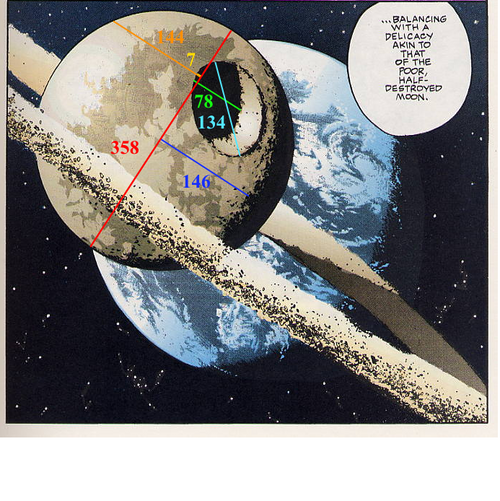The official discord link if you wish to join the discord: https://discord.gg/j5RKwCvAFu
Support the wiki on our official Ko-Fi page or Patreon page!
User:MrWarnerTheGreat/Akira - Tetsuo craters the moon
Introduction
Todd Ingram- I mean Tetsuo from Akira punches a hole in the moon (He's kinda the OG moon-wrecker). We'll be taking the shot where the crater is at its largest, since that is the full crater after the initial attack is commenced. Time to Codexify this feat!
The Calculation
Forming our Final Equation
Normally I would get the pixel measurements myself, but this feat is a rather iconic one, so it was already done several times in the past.

The moon's official diameter is 3476 kilometers, or 3476000 meters in full diameter. The red line is 358px in this shot, thus meaning the crater's diameter (cyan line) is 1301072.6257 meters.
Next up, we'll need the depth of the crater. The measurements above uses a bit of an irregular method to get the depth which I don't fully believe should be used, so we'll instead use a fourth of the diameter since that would make the most sense.
Next up, we can get our volume. Because the moon is a massive sphere, we'll be using an ellipsoid here. This makes the volume 5.7659815067561E+17 meters³ (5.7659815e+23cm³).
Now here's where things change drastically. For starters, it should be noted that this was not a compressive feat, as the sheer amount of rubble matter was enough to form a saturn-like ring around the moon.
For this reason, we'll assume two different ends for the feat. Our standard fracture formula, and a pulverization formula (Former is the "low-end" assumption, whereas the latter is the higher assumption).
Now, Igneous Rock, the rock material the moon is mostly composed of, has a fracture toughness of about 1.2 J/cm³.
Final Equation
Standard Fracture Toughness
5.7659815e+23(cm³)*1.2(J/cm³) = 6.9191778e+23 Joules, or 165.3723183556405445 Teratons of TNT. That's a good ways into Country level.
Pulverization Destruction
A particle of dust is five cubic micrometers or less, that is about two-thousand times smaller than a cubic centimeter.
(5.7659815e+23(cm³)*2000)*1.2(J/cm³) = 1.3838356e+27 Joules, which is about 330.74464627151053264 Petatons of TNT. That's several times above baseline Multi-Continent level.
Conclusion
Standard Fracture Toughness: 6.9191778e+23 Joules (165.3723183556405445 Teratons of TNT) - 6-B.
Pulverization Destruction: 1.3838356e+27 Joules (330.74464627151053264 Petatons of TNT) - High 6-A.
